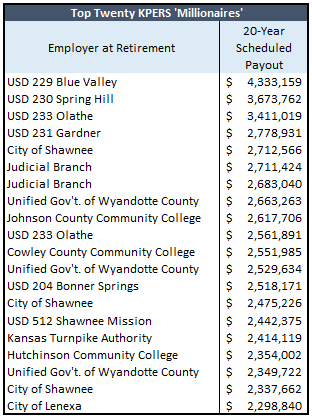 An Open Records request fulfilled by the Kansas Public Employees Retirement System (KPERS) shows record-setting payouts in 2017 of $1.64 billion. The number of KPERS ‘millionaires’ also set a new record, with 2,334 government retirees expected to receive more than $1 million in pension benefits over the first 20 years of retirement; that’s 327 more ‘millionaires’ than last year. Pensions are paid over the lifespan of each retiree, so actual payouts could be more or less. The twenty largest distributions are driven by those who elect partial lump sum distributions in their first year of retirement. A retiree from the Derby school district received the largest total payout last year at $610,791.
An Open Records request fulfilled by the Kansas Public Employees Retirement System (KPERS) shows record-setting payouts in 2017 of $1.64 billion. The number of KPERS ‘millionaires’ also set a new record, with 2,334 government retirees expected to receive more than $1 million in pension benefits over the first 20 years of retirement; that’s 327 more ‘millionaires’ than last year. Pensions are paid over the lifespan of each retiree, so actual payouts could be more or less. The twenty largest distributions are driven by those who elect partial lump sum distributions in their first year of retirement. A retiree from the Derby school district received the largest total payout last year at $610,791.
The KPERS system covers employees of state government, local government, school districts, and even some employees of private entities associated with government. Some university employees participate in KPERS but most of them are covered by a separate system. KPERS retirees have the option of taking a partial lump sum distribution upon retirement with reduced monthly benefits thereafter or they can collect their pension in regular monthly installments. KPERS retirees who reside in Kansas also receive preferential tax treatment. Their personal contributions are subject to state income tax when made but their withdrawals are exempt from state income tax, which means government retirees are never taxed most of their pension benefits, which come from employer contributions and earnings on all contributions.
 Educators dominate the twenty highest ‘millionaires’ list. There are seven school district employees in the top twenty and three people from community colleges. The City of Shawnee has three members of the top twenty, as does the Unified Government of Wyandotte County.
Educators dominate the twenty highest ‘millionaires’ list. There are seven school district employees in the top twenty and three people from community colleges. The City of Shawnee has three members of the top twenty, as does the Unified Government of Wyandotte County.
Educators also comprise the largest portion of the full list of ‘millionaires.’ School districts, education service centers and the Kansas Department of Education (KSDE) collectively have 650, or 28 percent of the total; including community and technical colleges, education accounts for a third of all ‘millionaires.’
City governments comprise the next largest group, with 25 percent of the total. County government has 21 percent of the ‘millionaires,’ with the majority of them retiring from Johnson County and the Unified Government of Wyandotte County, which includes the city of Kansas City, Kansas.
And given media coverage over pay levels in the courts and Highway Patrol, citizens may be surprised to learn that they collectively have 205 pension ‘millionaires.’
A complete list of pension ‘millionaires’ can be found here.




